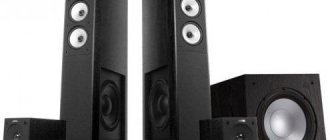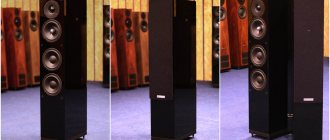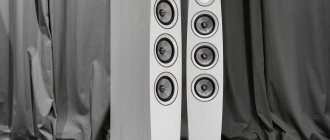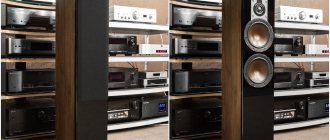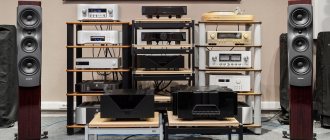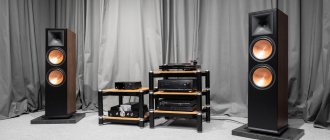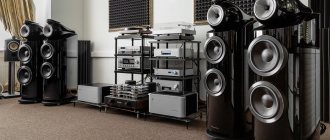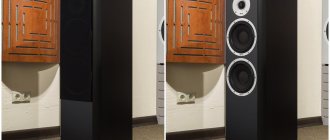Be an aristocrat
Well, the speakers are unpacked. What associations arise when you first look at the flutes and ornate shapes of Tannoy Kensington GR? Perhaps this is the sedate and solemn way of life of the English aristocracy during the heyday of the British crown, paintings in gilded frames, striking clocks, traditional five o'clock tea, green cloth offices and, of course, a well-trained servant who does not lose her dignity, who, despite all her delicacy, in principle unable to hide anything. If you have a sufficient budget for the purchase of these speakers, of course, it is not at all necessary to eat oatmeal, but the fact that their future owner is unlikely to want to walk next to them in underwear or without tightening their stomach, I am almost sure of this.
The high-precision processing of body fragments is no less surprising than the bizarre combination of their texture
You can feel from everything that the design of the speaker systems was developed by caring people with good taste and a sense of style. In their design, not only veneer is actively used, but also solid walnut. Despite the fact that modern woodworking technologies have long ago made it possible to abandon manual labor in the production of cases, their quality is still impeccable. The only thing that raises a question and, by the way, I’m not the only one, is the inconsistency of the veneer pattern, which is paradoxical for products of such a high level.
Usually in my reviews I ask about the compatibility of equipment design with the most popular stylistic interior solutions - from classic living rooms upholstered with tapestries to ultra-modern lofts reminiscent of avant-garde installations. The paradox is that in both the first and second cases such a vivid and expressive quote from the past looks more than appropriate. In any case, the so-called “female factor” will definitely remain on the side of these speakers, and their appearance in itself is worthy of contemplation.
The mood is right
Let's take a closer look at them. On the sides of the front panel there are four vertical grooves, closer to the middle, turning into the holes of the slotted bass reflex. Using the included key, we turn it in the keyhole with a pleasant click and carefully remove the dust net with the milled logo, exposing the front panel. The visual center of its compositional solution is the heart of the speaker system - a ten-inch coaxial Dual Concentric driver, in the center of which a gold-plated horn of the high-frequency head is installed. The contours of the emitter are emphasized by a gold-plated flange, surrounded by a small ring of dark, foam material, and the place where it is installed is decorated with an inlay of five vertical dark wood inserts. These inserts are not only an attractive design element, but also an effective technique to locally increase the inertia of the cabinet for improved reproduction of mid and low frequencies.
The control panel is divided into two parts: ENERGY - signal strength and ROLL OFF - its attenuation mode
Just below, on a massive brass plate, there is a high-frequency fine-tuning unit, which allows you to make minor adjustments to their sound, based on the individual preferences of the listener, as well as to correct the characteristics of the room. Visually, the control panel is divided into two parts: ENERGY - the signal value, varying from 1 kHz with amplitude up to ±3 dB and ROLL OFF - its attenuation mode, starting from 5 kHz. The switching itself is carried out by small screw terminals. Since acoustically neutral rooms are quite rare, the ability to adjust the signal seems quite appropriate. In addition, this allows you to more accurately match the sound of the speakers with the amplifier.
At the bottom of the rear panel there is an acoustic terminal assembled on a specially designed anti-resonance acrylic panel. Noteworthy is the high quality of the connectors used - NextGen WBT-0703, as well as their unusual quantity - 5 pieces. The fifth terminal is designed to ground the speakers to the amplifier housing. The terminals provide all the most popular connection types, including bi-wiring and bi-amping.
The fifth terminal of the speaker terminal is designed to effectively ground the amplifier
The acoustic systems themselves rest securely on massive pedestals resting on legs, which, if desired and with a sufficient level of physical fitness, can be removed and replaced with the above-mentioned complete spikes.
Specific family
Looking at the models from the Definition line, you immediately understand: Tannoy does not waste time on trifles. Even the DC8 bookshelf speaker, the lightest in the family, weighs ten kilos, while its taller floor-standing relatives approach the serious 40 kg mark. It is these floor-standing “strengths” that make up the main content of the Definition series - they are presented in the form of three different models, differing in the number of strips and the caliber of speakers.
Along with bookshelf and floor-standing speakers, the Definition series is equipped with a subwoofer and a central channel speaker (unlike satellites with their phasion reverters, the subwoofer is built in a closed housing, and a passive radiator is used in the central speaker). From such a set of “parts” you can put together a stereo system or a home theater, but the high-quality, emphatically conservative appearance of the speakers betrays their desire to please a stereophile rather than a movie buff. This feeling only intensifies with closer acquaintance with specific models.
Understand technology
The speaker cabinets are made of massive sheets of birch plywood in the signature Distributed Port acoustic design, with an integrated MDF labyrinth and a slot bass reflex. The inside of the housing is generously lined with foamed sound-absorbing material. For internal switching of components, a monocrystalline cable made of oxygen-free copper of high purity was used, and for connecting the high-frequency section, a monocore made of pure silver was used.
Where the emitter is mounted, the front panel is reinforced with five vertical inserts
The ten-inch diffuser of the mid/bass section of the coaxial emitter is made of cellulose with the addition of synthetic threads of short length, which, according to the developer, should contribute to much greater stability of its geometry and mechanical properties with increasing load, helping to combat resonance phenomena. To fix the diffuser, a two-layer textile suspension with a double wave impregnated with a special composition is used, providing significantly greater linearity and amplitude of vibrations. The shape of the diffuser is designed to ensure optimal dispersion of sound waves at the upper limit of the frequency range it reproduces. The basis of the electrodynamic system of the midrange/bass section is a powerful, permanent magnet made of the proprietary Alcomax 3 alloy, consisting of iron, aluminum, nickel and cobalt. According to the developers, the use of this alloy allows for high sensitivity, as well as softer and more natural sound reproduction.
The gold-plated “pepper shaker” of the high-frequency emitter is located in the center of the midrange/bass diffuser, made of cellulose with a small addition of artificial threads
A compression-type high-frequency driver with a two-inch diameter - the famous PepperPot - is loaded onto a proprietary gold-plated horn. The diffuser is made using a special five-stage technology from an alloy of magnesium and aluminum, which has an exceptionally high stiffness-to-weight ratio. The membrane is mounted on a proprietary Mylar suspension. A special cavity located behind the diffuser acts as a shock absorber (it can be said to coordinate the movements of the membrane and the acoustic properties of the horn).
A precision crossover connects both sections at 1.1 kHz and is designed to provide comprehensive equalization of both sections in both phase and amplitude. It is assembled on components that ensure minimal signal loss, using cryogenic processing technology to stabilize their crystal structure and relieve mechanical stress along the entire signal path.
Tannoy Definition Subwoofer: Bass giants
The weighty “cube” made of high-density birch MDF houses two giant 12-inch bass drivers with 2-inch four-layer coils, as well as aluminum diffusers that are resistant to overloads and deformations.
Subwoofer Tannoy Definition Subwoofer
The use of this 1000 Watt bass weapon with built-in Class D amplification allows you to deepen the low-frequency potential of the audio system to the infrasonic 19 Hz mark. And if the owner needs even more bass, a patch panel with a set of RCA and XLR interfaces will allow you to add another sub to the set.
Assemble the system
Despite the fact that, according to the manufacturer, the speaker systems are capable of working even with tube amplifiers, we decided not to tempt fate and test them with transistor components that meet our charges not only by name, but also by status. Testing took place in the Moscow salon “Nota+”, where we chose Gryphon components to accompany the acoustics: a Diablo 300 integrated amplifier with a power of 250 W (8 Ohms) and a Scorpio CD player, combined with a VIP XLR balanced cable and connected to the network with VIP M5 cables . We decided to listen to the speakers themselves in a room with a total area of about 40 m², connecting them with an acoustic cable SALab Speaker Cable.
The basis of the test path: Gryphon Diablo 300 amplifier and Gryphon Scorpio CD player
Before testing began, in accordance with the wishes set out in the operating instructions, the speaker systems were thoroughly warmed up, located at a distance of two meters from each other and turned 15 degrees so that their acoustic axes intersected at a short distance in front of the listening position. To eliminate the negative impact of re-reflections of acoustic waves, the distance from the walls was also maintained in accordance with the wishes set out in the instructions (at least a meter from the side walls and at least half a meter from the wall located behind).
This time we decided not to replace the standard legs with spikes, so they remained peacefully sleeping in the walnut chest, awaiting the attention of the future owner. The ground terminals also remained unused.
This time, as musical material for listening, I settled on the disc “The Essential” - a collection of songs with recordings by Marlene Dietrich, the disc “Classic Meets Cuba, Live” with a recording of a live concert by the Klazz Brothers and Cuba Percussion, a collection of popular songs performed by a male choir Sretensky Monastery and a standard selection of modern music and rock from EISA.
Listen to the best
To be honest, this was my first time testing speaker systems built on coaxial drivers of such a high level, so I will allow myself not to dwell on each disc individually, but to outline my general listening impressions.
The first thing you notice is their voice, capable of large-scale and effortless reproduction of the most complex phonograms, replete with the smallest details and contrasting dynamic pattern with monitor accuracy. The extremely tangible timbral texture of vocals, musical instruments and even the smallest rustles, inevitable during a live performance, are so precise that they produce the effect of a real revelation.
The GR logo is one of the many design elements emphasizing the aristocratic status of the acoustics
In some ways, the tenderness and power of their insightful “voices” can more appropriately be compared with the best examples of operatic singing, and only when playing individual tracks did I lack the density of sound in the mid-frequency range. No less impressive is the speaker's ability to reconstruct the stage, volume and acoustic space of the hall. Another significant feature of the acoustics being tested is the extremely wide angle of dispersion of sound waves and, as a consequence, the absence of a clearly defined zone for the most comfortable listening. Moving around the hall during the playback of soundtracks, I did not notice a pronounced blurring of the stereo panorama or a clear dominance of one of the channels.
The dust protection mesh fastening elements look extremely unusual
These speakers not only have outstanding dynamics, but also an amazing ability to draw the listener's attention to the most spectacular parts of the soundtrack. At the same time, they react quite sharply to the quality of the recording. Based on this feature, you shouldn’t delude yourself into thinking that the music that sounds great on your phone during your morning run will give you the same pleasure when listening to it on the Tannoy Kensington GR.
The sound of the acoustic systems throughout the entire frequency range is extremely consistent and organic, but I would like to highlight the low frequencies separately. Frankly, I did not expect such powerful and truly exciting bass reproduction from speakers based on a coaxial driver. It is extremely textured and so beautiful that I would probably not refuse to listen to soundtracks with recordings of bass parts.
A gilded key opens the doors to the secrets of unique sound
At the same time, Tannoy Kensington GR's performing style when playing modern musical genres, including rock music, seemed too prim. Everything seems to be fine, but without much ardor and enthusiasm. In any case, it is quite difficult for me to imagine Placido Domingo or Jose Carreras headbanging on stage to the sound of electric guitars. Still, the culture of listening to acoustics of this class presupposes corresponding musical material.
High society
The appearance of the acoustics will cause, if not awe, then at least the respect of an experienced audiophile. The case is large; compared to it, even the Canterbury model looks rather modest. Natural finishes and classic design require an appropriate interior and atmosphere. You can’t help but look for lush armchairs with carved legs in the Victorian style and a table with a bottle of 12-year-old single malt whiskey. Electronics, of course, should also be considered equal: something warm, tube-based, vintage, definitely analog.
In this test, the GRF90 was paired with a McIntosh kit with analog green indicators and needles. We will leave the fact that we were not listening to vinyl at all, but to a digital CD, outside the brackets, since the visual component corresponded to the image 100%. Technical too: two hundred watts per channel with a long-term acoustic power of 140 W and a sensitivity of 95 dB is enough to create a hurricane in a single room.
To understand the dimensions of acoustics: the dimensions of sound-absorbing panels on the walls are 50x50 cm
The fact that large and powerful speakers need a large room is understandable, I think to everyone. But another fact is not obvious to everyone, namely: the proprietary coaxial emitter, even if it is a point source of sound, has a narrow sound wave dispersion - according to the passport, only 90 degrees. Therefore, the sound at the focal point and outside it is different. This concerns, first of all, the high frequencies, because the narrow focus is due to the deeply hidden tweeter.
In fact, it cannot be said that the sound outside the VIP zone was worse. In my opinion, it’s even the other way around: due to the fact that there are more high frequencies at the focal point, the sound turns out sharper and you begin to involuntarily listen to audiophile subtleties and look for nuances. Being away from the point makes it easier to focus on the music, emotions, and listen not to how the tweeter copes with playing the hi-hat, but how accurately the drummer plays the swing rhythm, and how harmoniously the laid-back vocals of the great Frank Sinatra lie on it. This gave me the idea that the frequency controls on the front of the acoustics are useful - with their help, the acoustics are adjusted to different music, you can shift the emphasis from high to mid frequencies and vice versa.
The most interesting fact is that even with a strong shift relative to the focal point, a completely natural feeling of the sound stage remains. In most cases, leaving the VIP zone leads not only to a distortion of the tonal balance, but also to a complete loss of the sense of volume and depth, but in the case of the GRF90 you can move around the room quite freely without losing the scale and proportions of the sound picture.
A paper diffuser with a fabric suspension is an absolute classic, and how exquisitely designed is the speaker flange!
As for bass reproduction, I got the feeling that even a large and well-prepared showroom was not fully prepared for the behavior of the acoustics at medium volume. The bass was lively, velvety, warm, literally enveloping from all sides, but when the volume was increased, it seemed as if there was not enough space in the room; I wanted to place the acoustics wider, sit further away, turn it up louder and feel it to the fullest. This is a question of potential, the full development of which I have not been able to reach. The reverse situation is no less surprising, when the acoustics play quietly. It's hard to believe that such monsters are capable of playing carefully, subtly and delicately.
I will note a prominent and fast midrange, a softened top (provided the controls are set to “zero”) with natural transmission of the lower part of the high-frequency range and rich, measured bass. The scene is built closely and does not go beyond the stereo base.
conclusions
Before putting the last final chord in this review, I would like to note that you need to come to the purchase of Tannoy Kensington GR, either having solid experience of listening to high-end acoustics, or trusting the expert assessments and authority of the company. I admit that to an inexperienced listener their extremely natural and natural sound may even seem a little boring at first, as if he tried products without a flavor enhancer or, on a hot day, spring water instead of bubbling sweet cola.
It cannot be said that the tested acoustics equally successfully play music of different genres, but all those who prefer live acoustic recordings should take a closer look at these certainly outstanding speakers, not forgetting their careful attention to the quality of the reproduced phonograms.
Based on the testing results, I can confidently say that the Tannoy Prestige Kensington GR is one of the most interesting and original speaker systems on the market in the High End segment. In any case, we can say with confidence that if there is a sufficient budget and space to accommodate them, the future owner of these speakers is unlikely to be disappointed in his choice.
Advantages: design, workmanship, high-end sound
Disadvantages: genre preferences, high requirements for the quality of phonograms
Official website: Tannoy Kensington Gold Reference
Price: 1,261,200 rubles

